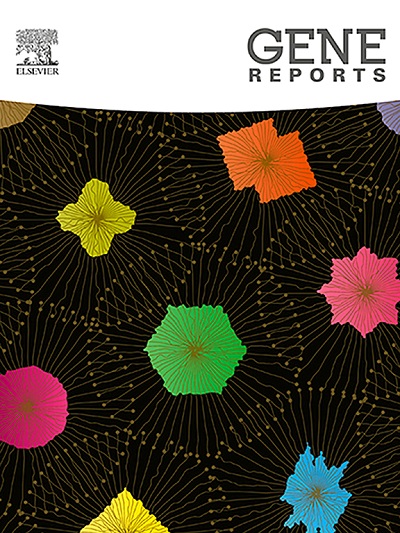Molecular study of glpT and uhpT genes as fosfomycin transport systems in uropathogenic Staphylococcus aureus
IF 1
Q4 GENETICS & HEREDITY
引用次数: 0
Abstract
Antibiotic resistance is a significant problem that requires new treatments. There is growing concern about fosfomycin resistance in Staphylococcus aureus; understanding this resistance will help develop effective treatment strategies and preserve antibiotic efficacy. This study investigates the impact of glycerol-3-phosphate transporter (GlpT) and hexose phosphate transporter (UhpT) mutations on fosfomycin uptake and resistance.
Methods
This study isolated and identified S. aureus isolates from urine samples; the diagnosis was made using the 16S rRNA gene (as specific gene detection). The study examined the antibacterial properties of fosfomycin using the minimum inhibitory concentration (MIC). The study also used molecular assays to identify, sequence, and determine the expression levels of fosfomycin resistance genes (glpT and uhpT) under different treatments.
Results
The genetic methods identification of S. aureus by 16S rRNA gene showed all isolates gave positive results. Compared to the breaking point, the number of S. aureus isolates recorded MIC concentration ≥ 256 μg/ml was 24 % (12 isolates) and appeared resistant to Fosfomycin. There was a decrease in gene folding expression for the efflux pump system in response to the different treatments.
Conclusions
The study shows the prevalence of resistance to fosfomycin. The molecular assays reveal the genetic aspects of resistance and its modification. Fosfomycin resistance included transporter (efflux pump) (glpT and uhpT) genes and variable gene expression changes under different treatments.

求助全文
约1分钟内获得全文
求助全文
来源期刊

Gene Reports
Biochemistry, Genetics and Molecular Biology-Genetics
CiteScore
3.30
自引率
7.70%
发文量
246
审稿时长
49 days
期刊介绍:
Gene Reports publishes papers that focus on the regulation, expression, function and evolution of genes in all biological contexts, including all prokaryotic and eukaryotic organisms, as well as viruses. Gene Reports strives to be a very diverse journal and topics in all fields will be considered for publication. Although not limited to the following, some general topics include: DNA Organization, Replication & Evolution -Focus on genomic DNA (chromosomal organization, comparative genomics, DNA replication, DNA repair, mobile DNA, mitochondrial DNA, chloroplast DNA). Expression & Function - Focus on functional RNAs (microRNAs, tRNAs, rRNAs, mRNA splicing, alternative polyadenylation) Regulation - Focus on processes that mediate gene-read out (epigenetics, chromatin, histone code, transcription, translation, protein degradation). Cell Signaling - Focus on mechanisms that control information flow into the nucleus to control gene expression (kinase and phosphatase pathways controlled by extra-cellular ligands, Wnt, Notch, TGFbeta/BMPs, FGFs, IGFs etc.) Profiling of gene expression and genetic variation - Focus on high throughput approaches (e.g., DeepSeq, ChIP-Seq, Affymetrix microarrays, proteomics) that define gene regulatory circuitry, molecular pathways and protein/protein networks. Genetics - Focus on development in model organisms (e.g., mouse, frog, fruit fly, worm), human genetic variation, population genetics, as well as agricultural and veterinary genetics. Molecular Pathology & Regenerative Medicine - Focus on the deregulation of molecular processes in human diseases and mechanisms supporting regeneration of tissues through pluripotent or multipotent stem cells.
 求助内容:
求助内容: 应助结果提醒方式:
应助结果提醒方式:


